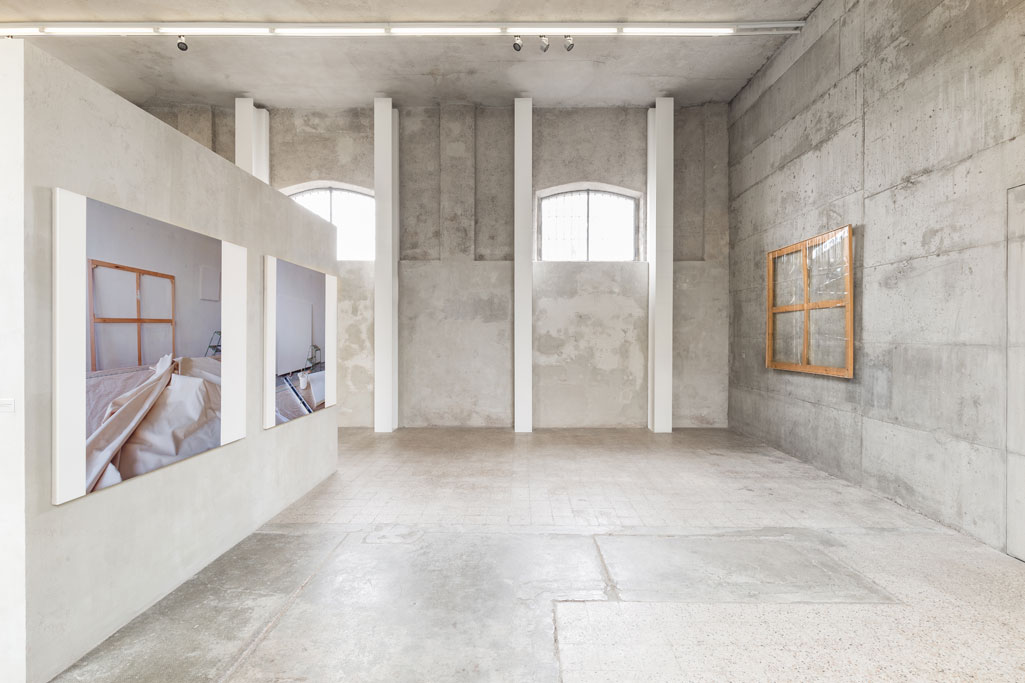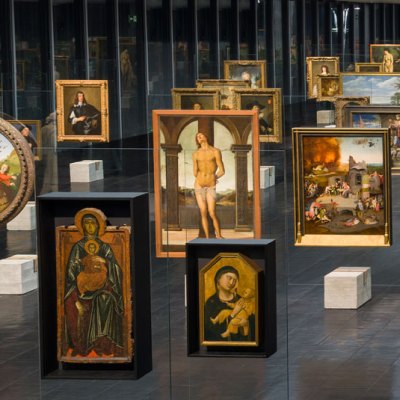From the February issue of Apollo: preview and subscribe here
The pristine facade of the Fondazione Prada in Milan, which opened early last year, has yet to fade. Among the varied programme at the former distillery, converted by Rem Koolhaas into a site of extravagant minimalism, is a deft and unexpectedly political exhibition, ‘Recto Verso’, which takes as its subject the unseen side of the canvas. Curated by the Fondazione’s Orwellian-sounding ‘Thought Council’, its opening trompe l’oeil, Louis-Léopold Boilly’s Le Chat gourmand crevant une toile pour manger des harengs, is doubly deceptive. The painting of a cat breaking through the back of a canvas is the only true trompe-l’oeil in the exhibition, and the only pre 20th-century work. The straightforwardness of its conceit seems naive in comparison to its neighbours: Gerard Byrne’s Trompe l’oeil. The Reverse of a Framed Painting (2008), inspired by Cornelis Gijsbrecht’s c. 1670 painting of the back of a canvas, and Philippe Gronon’s 2009 Verso n.38, Nymphéas par Claude Monet, an image of the back of one of Monet’s few circular Water Lilies. While both photographs show the plain space behind the painting, Byrne’s monochrome image gives that structure its own status as a subject, while Gronon’s – which reveals the stickers and labels acquired by the painting through its exhibition history – invites us to consider the painting as artefact.
‘Recto Verso’ exhibition view at Fondazione Prada, Milan. Showing ‘Antologia’ (1974) by Giulio Paolini. Photo: Delfino Sisto Legnani Studio. Courtesy Fondazione Prada.

Works by Matts Leiderstam in the second room – prints of the verso and recto of 17th-century paintings which project out from the wall – continue this theme. The painting is no longer just the face which the artist or gallery presents, but an object in space, exposed to the viewer in a way usually reserved for those privileged to handle it. That works which attempt to deconstruct the mystique of art-world power are being shown by the Fondazione Prada is inevitably ironic, but they are making a statement too: their flipped canvases are a rejoinder to art market ‘flipping’, where collectors buy up-and-coming works intending to resell them quickly at a profit. Giulio Paolini’s Antologia (26/1/1974), in the main gallery-space, critiques such modishness by refusing to share – show – anything. Formed of two canvases joined face-to-face and decorated on both ‘backs’ with invitations to now long-past exhibitions (Cy Twombly, Warhol in New York), the ‘art’ – the painted face – is hidden.
‘Recto Verso’ exhibition view at Fondazione Prada, Milan. Showing Matts Leiderstam’s ‘Kat. Nr. 1356 (Unknow Unknow)’ and ‘Kat. Nr. 0313 (Unknown Unknown) on the left (both 2014). Photo: Delfino Sisto Legnani Studio. Courtesy Fondazione Prada.

Ambiguity between front and back concerns the many pieces by artists associated with Arte Povera and Supports/Surfaces, which deconstruct painting by making its constituent materials the subject as well as the body of the works. Carla Accardi’s 1976 Grande trasparente is a wooden frame stretched with sicofoil, a clear plastic. She first used the material as a surface for paint; later, the weave and wrap of it around the support is the work itself.
‘Recto Verso’ exhibition view at Fondazione Prada, Milan. Showing ‘Support Surface’ (2007), by Ian Wallace (left) and ‘Grande trasparente’ (1976) by Carla Accardi (right). Photo: Delfino Sisto Legnani Studio. Courtesy Fondazione Prada.

Supports/Surfaces formed in the south of France in the mid 1960s as a means of, according to founding member Daniel Dezeuze, ‘revolting against the art world and the world without having to make anti-art’. Unlike their Parisian contemporaries, they followed American theory – Greenberg especially – and thought the crisis of painting wouldn’t be solved by rejecting it altogether but by returning, quite literally, to the essential conditions of the medium. A particular delight is the pairing of Dezeuze’s most radical work, Châssis avec feuille de plastique tendue (1967), a wooden canvas frame propped against the wall (the ‘support’ element), opposite a bronze piece from Louis Cane’s Sol/Mur series (1974–75) of beautifully dyed canvases that hang directly from the wall and spill out on to the floor (the ‘surface’). More radical still is Gastone Novelli’s Lutte, échec, nouvelle lutte. The painting has transformed since the artist turned it to face the wall in protest at the 1968 Venice Biennale, and daubed ‘La Biennale è fascista’ on the back. The back is now as much part of the work as the front, and it’s the latter dimension that is foregrounded in a city that was the site of similar protest at last year’s Expo.
‘Recto Verso’ exhibition view at Fondazione Prada, Milan. Showing ‘Sol / Mur’ (1974) by Louis Cane (left) and ‘Châssis avec feuille de plastique tendue’ (1967), by Daniel Dezeuze (right). Photo: Delfino Sisto Legnani Studio. Courtesy Fondazione Prada.

Many of the works extend beyond their usual confines – standing on the floor, projected into the air, leaning against a wall. Those that are ‘hung’ seem suddenly flat and formal; though it’s worth being reminded that paintings are still defined by that separation of dimensions between viewer and work that other works here are trying to collapse. The main gallery, a strip-lit concrete arcade, has been divided to create a series of pairings, contemporary comparisons, and cross references. Michelangelo Pistoletto’s 31 wooden slats, Un libro, il lato letterario del quadro, each a diary entry for June 1970 that can be reconfigured with every showing, face two recent works by Pierre Toby – monochrome canvases in black and rose, propped up against the opposite wall as though in dialogue. Accardi pieces hang opposite Ian Wallace’s Support Surface (2007) – two photo-canvases that reference Dezeuze’s Châssis – and Lichtenstein’s jaunty Stretcher frame with vertical bar (1968), a faux-trompe l’oeil (here the connections become especially fun: Greenberg hated Lichtenstein). But the exhibition feels at times like an exercise in curatorial agility: the work isn’t contextualised and its political suggestiveness is left dormant, its theoretical conflict unexamined. There’s even more behind these works.
‘Recto Verso’ is at the Fondazione Prada, Milan, until 14 February.



